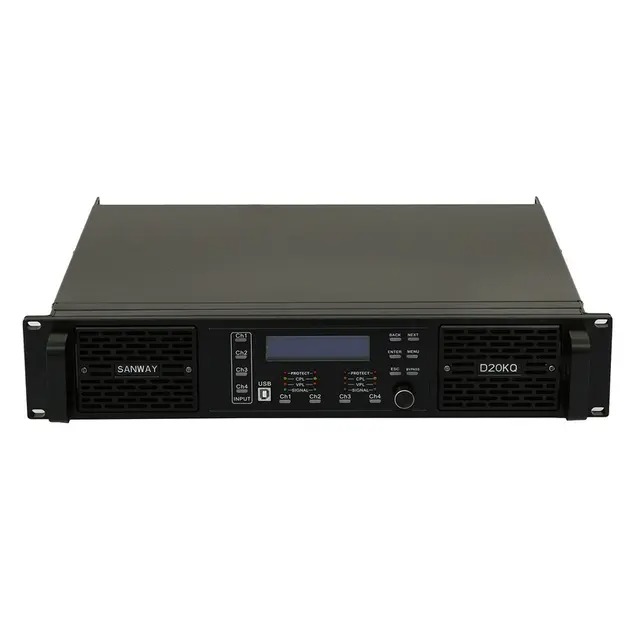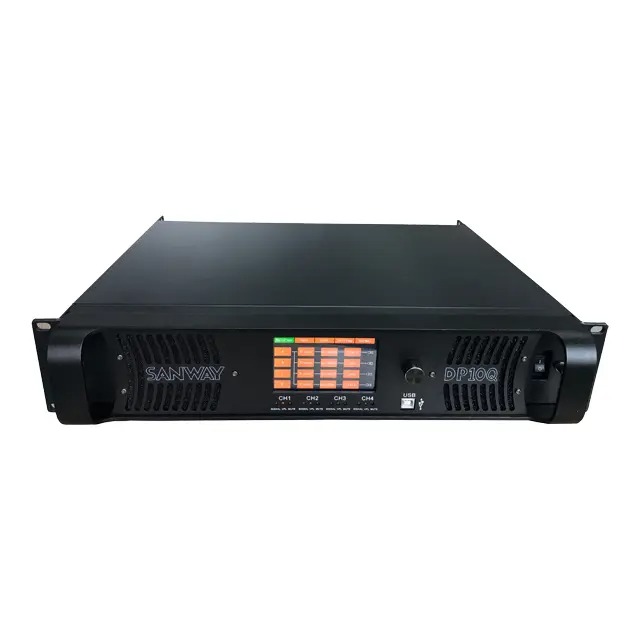
As audio technology advances, digital power amplifiers have become an increasingly popular choice among audiophiles, engineers, and casual listeners alike. With promises of higher efficiency, compact design, and improved integration with modern digital systems, they are often positioned as the future of sound amplification. But a key question remains: Do digital amplifiers affect sound quality? In this article, we will explore the nature of digital amplifiers, how they compare to traditional analog designs, and whether their digital architecture enhances or hinders the listening experience.
What Is a Digital Power Amplifier?
A digital power amplifier, also known as a Class D amplifier, is a type of amplifier that uses digital switching technology to increase efficiency and reduce heat output. Unlike traditional analog amplifiers that use continuous signal modulation, digital amplifiers work by converting audio signals into a series of high-frequency digital pulses that switch the output transistors on and off. These pulses are then filtered back into an analog waveform, which is delivered to the speakers.
This method of amplification results in extremely efficient performance—typically over 90%—which allows for smaller size, less heat dissipation, and longer component life. However, this transformation process raises questions about how faithfully the sound signal is preserved, leading some to speculate whether digital amplifiers compromise audio fidelity in favor of practical benefits.

Digital vs. Analog Amplifiers: What's the Difference?
When evaluating whether digital amplifiers affect sound quality, it’s helpful to understand how they differ from their analog counterparts. Analog amplifiers, such as Class A, Class AB, or Class B, amplify signals in a linear fashion. The input signal is directly modulated and output in an analog form without intermediate digital processing. This directness can provide a "warmer," more natural sound, which is often preferred in audiophile communities.
On the other hand, digital amplifiers use Pulse Width Modulation (PWM) or similar techniques to represent analog input signals digitally before amplification. This introduces a conversion process that involves analog-to-digital and digital-to-analog stages, where some fidelity loss can occur if not properly managed.
Here is a simple comparison table:
| Feature | Analog Amplifiers | Digital Amplifiers |
| Efficiency | 30%–60% | 85%–95% |
| Heat Output | High | Low |
| Size | Larger | Compact |
| Audio Fidelity (Subjective) | Warm, natural | Clean, sometimes sterile |
| Signal Processing | Pure analog | Digital conversion involved |
| Application | High-end audio systems | Portable speakers, car audio |
While analog amplifiers may produce more distortion, it is often described as "musical" or "harmonically rich," while digital amplifiers aim for precision, which can sometimes be perceived as clinical or lacking depth, especially in poorly implemented systems.
How Digital Amplifiers Impact Sound Quality
Sound quality is a complex combination of technical accuracy and subjective perception. Digital power amplifiers, by design, prioritize efficiency and signal integrity, often resulting in a sound that is tight, fast, and highly detailed. However, the following aspects play a significant role in determining the actual sound quality of a digital amplifier:
1. Sampling and Resolution
Digital amplifiers operate by interpreting the incoming signal at a certain sample rate and bit depth. Higher sampling rates and bit depths allow for more detailed signal processing, minimizing potential losses during conversion. A poorly designed digital amplifier with a low sample rate may miss subtle audio nuances, while a high-resolution system can maintain transparency and realism.
2. Switching Frequency
Most digital amplifiers operate at high switching frequencies—often above 400kHz—to minimize distortion and allow better filtering of the output. If the switching frequency is too low or not properly filtered, audible noise or artifacts may be introduced into the signal.
3. Output Filter Design
A critical component in digital amplification is the low-pass filter that reconstructs the analog signal from digital pulses. Poor filter design can result in signal degradation, phase distortion, or even harmonic distortion, all of which degrade sound quality. A well-designed filter ensures that the final sound remains faithful to the original source.
4. Power Supply Stability
The power supply's design significantly affects amplifier performance. Digital amplifiers rely heavily on clean, stable power. Inadequate power regulation can introduce noise, affect dynamics, and compromise the overall listening experience.
Therefore, while digital amplifiers can deliver excellent sound quality, especially in well-engineered systems, they require meticulous design to avoid sonic compromises.
The Human Ear and the Perception of Audio Quality
One of the most fascinating aspects of the analog vs. digital debate is the role of human perception. Our ears and brains interpret sound in ways that are not always measurable by objective metrics. For instance, total harmonic distortion (THD) in digital amplifiers may be lower, yet some listeners still prefer the harmonic coloration of analog distortion.
This leads to a subjective dimension where preference often overrides specifications. An amplifier with perfectly flat frequency response and low distortion might sound lifeless or "cold" to one person, while another might praise it for its clarity and precision.
Additionally, psychological factors such as expectation bias and listening environment play a role in perceived quality. High-end speakers and acoustically treated rooms might reveal minor differences, whereas in casual setups, such nuances might go unnoticed.

Are Digital Amplifiers Better for Specific Applications?
Digital amplifiers have become the backbone of modern consumer electronics, including soundbars, Bluetooth speakers, and car audio systems. Their compact size, minimal heat output, and efficiency make them ideal for space-constrained environments.
However, in audiophile or studio settings, analog amplifiers still hold a strong position due to their musical character and organic sound. Here’s a breakdown of where digital amplifiers shine versus where analog may be preferred:
| Application Area | Recommended Amplifier Type | Reason |
| Home Theater Systems | Digital Power Amplifier | High efficiency, multi-channel ease |
| High-End Audio | Analog Amplifier | Warmth, harmonic richness |
| Car Audio Systems | Digital Power Amplifier | Compact, cool-running design |
| Studio Monitors | Analog or Hybrid | Detailed, linear response |
| Portable Bluetooth Devices | Digital Power Amplifier | Power-efficient, light-weight |
So while digital amplifiers are not inherently inferior, their application should match their strengths—efficiency, clarity, and compactness—while recognizing that certain listening scenarios may benefit from the characteristics of analog amplification.
Frequently Asked Questions (FAQ)
Q1: Do digital amplifiers sound worse than analog amplifiers?
Answer: Not necessarily. While early digital amps had issues with distortion and fidelity, modern digital power amplifiers—when well-designed—can deliver sound quality that rivals or even exceeds analog amplifiers. The final result depends on components, circuit design, and use-case suitability.
Q2: Are digital amplifiers suitable for audiophiles?
Answer: They can be. Some audiophiles appreciate the precision and neutrality of high-end digital amplifiers. However, others still prefer the warmth and color of analog amplification. It comes down to personal taste and audio system synergy.
Q3: Can digital amplifiers damage my speakers?
Answer: No, digital amplifiers are no more likely to damage speakers than analog ones, provided they are correctly matched in power and impedance. Poor quality or mismatched equipment can lead to issues, regardless of amplifier type.
Q4: Why are digital amplifiers more efficient?
Answer: Digital amplifiers use switching transistors that are either fully on or off, which reduces energy loss as heat. This contrasts with analog amplifiers, where transistors operate in a linear region and dissipate more energy.
Q5: Do digital amplifiers introduce latency?
Answer: In most cases, the latency introduced by digital amplification is negligible and imperceptible to the human ear. However, in critical real-time applications, such as professional audio monitoring, ultra-low-latency designs may be preferred.
Conclusion
In summary, digital power amplifiers do affect sound quality, but not necessarily in a negative way. The impact depends heavily on design quality, application, and user expectations. For many, digital amplifiers offer the ideal balance of performance, convenience, and energy efficiency. For others—especially those who value analog warmth and coloration—traditional designs still reign supreme.

 English
English










